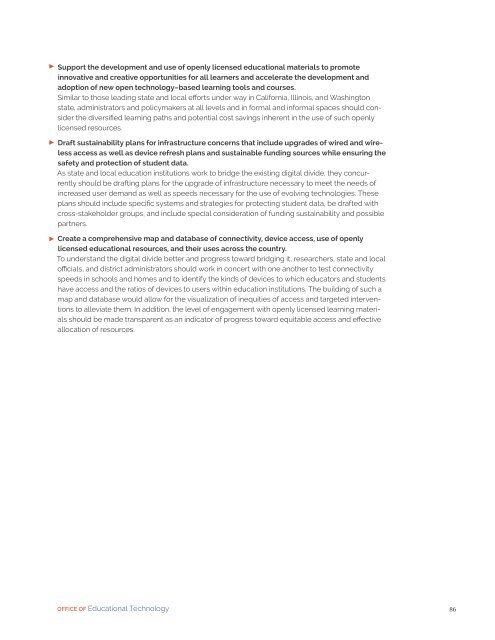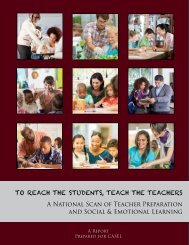Future Ready Learning
7m3sdJ
7m3sdJ
You also want an ePaper? Increase the reach of your titles
YUMPU automatically turns print PDFs into web optimized ePapers that Google loves.
Support the development and use of openly licensed educational materials to promote<br />
innovative and creative opportunities for all learners and accelerate the development and<br />
adoption of new open technology–based learning tools and courses.<br />
Similar to those leading state and local efforts under way in California, Illinois, and Washington<br />
state, administrators and policymakers at all levels and in formal and informal spaces should consider<br />
the diversified learning paths and potential cost savings inherent in the use of such openly<br />
licensed resources.<br />
Draft sustainability plans for infrastructure concerns that include upgrades of wired and wireless<br />
access as well as device refresh plans and sustainable funding sources while ensuring the<br />
safety and protection of student data.<br />
As state and local education institutions work to bridge the existing digital divide, they concurrently<br />
should be drafting plans for the upgrade of infrastructure necessary to meet the needs of<br />
increased user demand as well as speeds necessary for the use of evolving technologies. These<br />
plans should include specific systems and strategies for protecting student data, be drafted with<br />
cross-stakeholder groups, and include special consideration of funding sustainability and possible<br />
partners.<br />
Create a comprehensive map and database of connectivity, device access, use of openly<br />
licensed educational resources, and their uses across the country.<br />
To understand the digital divide better and progress toward bridging it, researchers, state and local<br />
officials, and district administrators should work in concert with one another to test connectivity<br />
speeds in schools and homes and to identify the kinds of devices to which educators and students<br />
have access and the ratios of devices to users within education institutions. The building of such a<br />
map and database would allow for the visualization of inequities of access and targeted interventions<br />
to alleviate them. In addition, the level of engagement with openly licensed learning materials<br />
should be made transparent as an indicator of progress toward equitable access and effective<br />
allocation of resources.<br />
OFFICE OF Educational Technology<br />
86



